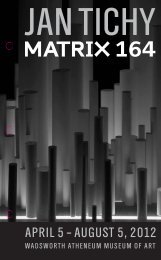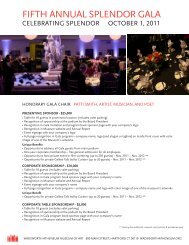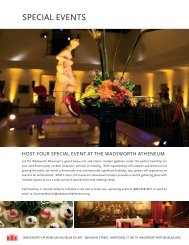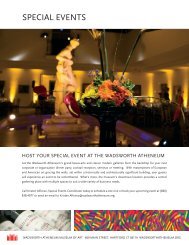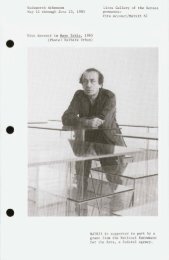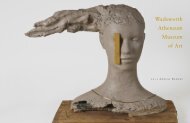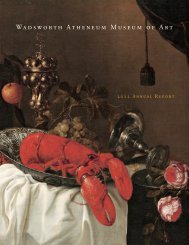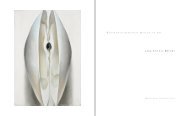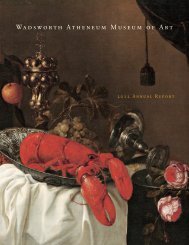Luis Egidio MeléndezSpanish, 1716–1780Still Life with Pigeons, Onions, Bread, <strong>and</strong> Kitchen Utensils, c. 1772Oil on canvas<strong>The</strong> Ella Gallup Sumner <strong>and</strong> Mary Catlin Sumner Collection Fund, 1938.256An e<strong>art</strong>henware jug, a copper bowl, onions, garlic, bread, <strong>and</strong> a pigeon would be <strong>the</strong> ingredientsfor a humble meal, but Meléndez has arranged <strong>the</strong>m with sensitivity, brilliantly using light todescribe <strong>the</strong>ir varied colors <strong>and</strong> textures. With flawless technique <strong>the</strong> <strong>art</strong>ist produced adistinctive realism with powerfully modeled objects against neutral backgrounds, viewed closeupfrom a low vantage point.Meléndez was an acknowledged master <strong>of</strong> <strong>the</strong> still life, <strong>and</strong> painted more than one hundred <strong>of</strong><strong>the</strong>m between 1759 <strong>and</strong> 1778.Charles-François Grenier de La Croix, called Lacroix de MarseilleFrench, c. 1700–1782Seascape with a Ruined Arch, 1780Oil on copperGift <strong>of</strong> Mary Batterson Beach, 1946.89Lacroix produced countless modest coastal scenes, all imaginary. This seascape, which is notstrictly a topographical representation, strongly suggests sites on <strong>the</strong> itinerary <strong>of</strong> many a travelerthrough Italy, where Lacroix had spent time in <strong>the</strong> 1750s: <strong>the</strong> hills <strong>and</strong> cascades <strong>of</strong> Tivoli; <strong>the</strong>harbor, lighthouses, <strong>and</strong> old fortresses <strong>of</strong> Naples; or <strong>the</strong> undeveloped coastline near Naples <strong>and</strong>Rome.CASEPair <strong>of</strong> Vases (urnes duplessis)French, Vincennes, 1749–51S<strong>of</strong>t-paste porcelainGift <strong>of</strong> J. Pierpont Morgan, 1917.977–.978Flowers adorned decorative objects <strong>of</strong> all types in <strong>the</strong> eighteenth century. <strong>The</strong> Vincennesporcelain factory, predecessor <strong>of</strong> <strong>the</strong> Sèvres porcelain factory, embraced <strong>the</strong> taste for floralornamentation with enthusiasm. In this pair <strong>of</strong> vases, flowers sculpted out <strong>of</strong> porcelain—bywomen employed in a specialized workshop for <strong>the</strong> factory—were applied to <strong>the</strong> vases,seeming to grow naturally from <strong>the</strong> feet toward <strong>the</strong> entwined branch h<strong>and</strong>les.
CASETea Kettle <strong>and</strong> St<strong>and</strong>English, London, 1758–59Samuel Courtauld I, active from 1747, died 1765Silver, wood<strong>The</strong> Elizabeth B. Miles Collection <strong>of</strong> English Silver, 1979.45This kettle is decorated with flowers <strong>and</strong> scrolls on <strong>the</strong> body, a cast flower finial, a shell-likeornament on <strong>the</strong> spout, <strong>and</strong> a st<strong>and</strong> with grape vines <strong>and</strong> shell feet. Such nature-based decorationwas a hallmark <strong>of</strong> <strong>the</strong> Rococo style that swept Europe in <strong>the</strong> middle decades <strong>of</strong> <strong>the</strong> eighteenthcentury.<strong>The</strong> H<strong>and</strong> KissGerman, Meissen, c. 1738Model by Johann Joachim KaendlerHard-paste porcelainGift <strong>of</strong> J. Pierpont Morgan, 1917.1498Images <strong>of</strong> figures living as simple shepherds in bucolic, l<strong>and</strong>scape settings abound in literature,<strong>the</strong>ater, <strong>and</strong> <strong>the</strong> visual <strong>art</strong>s. This idealized depiction <strong>of</strong> <strong>the</strong> natural world is echoed in porcelainfigures such as <strong>the</strong>se shepherds <strong>and</strong> lovers.Tea Set (déjeuner à baguettes)French, Sèvres, 1776Decorated by Guillaume Noël, active 1755–1800S<strong>of</strong>t-paste porcelainGift <strong>of</strong> J. Pierpont Morgan, 1917.1090–.1094Tea (as well as c<strong>of</strong>fee <strong>and</strong> chocolate) was consumed in bedrooms, boudoirs, salons, gardens, <strong>and</strong>in <strong>the</strong> bath, <strong>and</strong> was taken at breakfast time <strong>and</strong> at formal receptions. Teapots usually were small,as <strong>the</strong>y were meant to hold very strong tea that would be diluted with boiling water served from ametal kettle.



